Contents
Description
Mustard oil is made from three types of mustard seeds: white, gray and black. The exact time of the beginning of mustard cultivation is not known for certain, but there is even mention of mustard seeds in the Bible.
In Europe, mustard has been known since the ancient Greek civilization, but it was cultivated as a culture and mustard oil was produced from seeds much later.
At the beginning of the nineteenth century, the German Konrad Neutz bred a new variety of mustard, which was later called Sarepta, he also developed the first technology in Russia for processing mustard seeds into oil. In 1810 a mustard oil mill was opened in Sarepta.
Towards the middle of the nineteenth century, Sarep mustard oil and powder were recognized as the best in the world.
The history of mustard oil
Throughout the centuries-old history of its existence, mustard is a well-known spice in many countries, not only because of its excellent taste, but also because of its amazing medicinal properties.
Bearing in the ancient Indian language the name “destroying leprosy”, “warming”, mustard already in the first millennia of our era found wide application in folk medicine of Ancient Greece and Rome (the first mention of the miraculous properties of wild mustard dates back to the 1st century BC .)
Eastern China is considered to be the homeland of gray (Sarepta) mustard, from which this spice first came to India, and then from there it “migrated” to other countries of Asia and southern Europe.
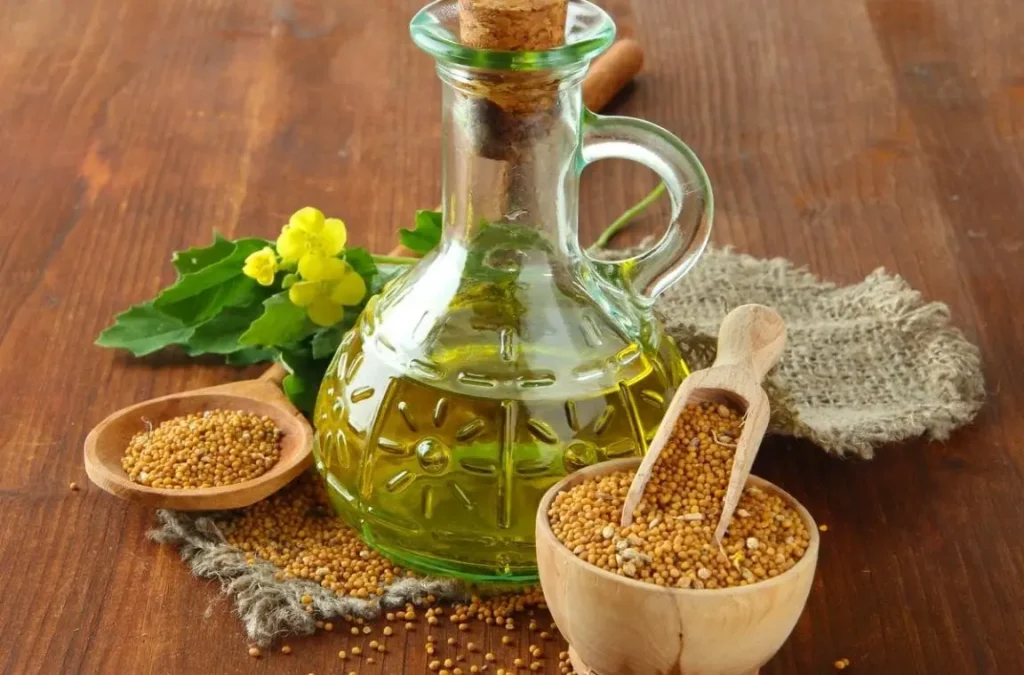
The process of processing mustard seeds into oil is of two types: pressing (hot or cold pressing) and extraction (extracting a substance from a solution using special solvents).
Mustard oil composition
Mustard oil, which belongs to valuable edible vegetable oils, is distinguished by a high content of biologically active substances necessary for the human body every day (vitamins (E, A, D, B3, B6, B4, K, P), polyunsaturated fatty acids (vitamin F), phytosterols, chlorophyll , phytoncides, glycosides, essential mustard oil, etc.).
The composition of mustard oil contains a significant amount of linoleic acid (belonging to the Omega-6 group) and linolenic acid, which is similar in its effect on the human body to the polyunsaturated Omega-3 acids contained in flaxseed oil or fish oil.
Mustard oil contains the antioxidant vitamin A. Of the fat-soluble vitamins, vitamin E also occupies an important place in the mustard oil (in terms of its content, mustard oil is several times higher than sunflower oil).
Mustard oil is also an excellent source of vitamin D (this fat-soluble vitamin is 1.5 times more in mustard oil than in sunflower oil). Mustard oil contains vitamin B6, and also promotes the synthesis of this vitamin by the intestinal microflora. Vitamin B3 (PP), which is part of mustard oil, is necessary for the implementation of energy metabolism in the human body.
Mustard oil is also very rich in choline (vitamin B4). Vitamin K (“antihemorrhagic vitamin”) contained in mustard oil helps prevent hemorrhages. The composition of mustard oil is also characterized by a high content of biologically active substances of phytosterols (“plant hormones”).

Mustard oil also contains a large amount of phytoncides, chlorophylls, isothiocyanates, synegrin, essential mustard oil – substances with powerful bactericidal and antitumor properties.
Mustard oil production
The production of mustard oil consists of several stages and the first is the preparation of the seeds. First, mustard seeds are processed from impurities using special equipment.
Spinning
Cold pressing technology dates back to ancient times to the present. It is used for the production of high quality and clean environmentally friendly products. However, this method does not allow to extract more than 70% of oils from raw materials.
Often in many industries, hot-pressing technology is used, which allows the production of up to ninety percent of the oil. It takes place in two stages:
Primary pressing, converting seeds into oil and cake.
Secondary pressing, which practically leaves no oil content in the cake.
This is followed by extraction. This method of obtaining oil has been known since the end of the nineteenth century, the Germans were the first to come up with it. It is based on a method of extracting oil from seeds using special solvents. The solvent, penetrating into the seed cells, removes the oils outside.
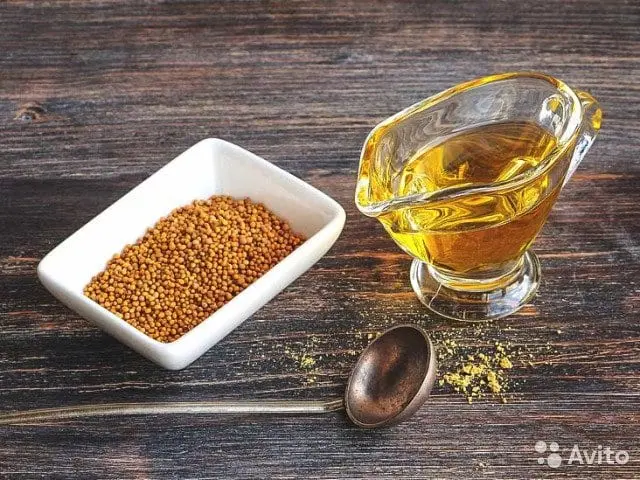
Oil refining
Oil refining (or distillation) drives the solvent out of the oil, resulting in unrefined mustard oil.
To get refined oil, it must go through the following stages of purification:
- Hydration.
- Refining.
- Neutralization.
- Freezing.
- Deodorization.
Unfortunately, it is impossible to cook mustard oil at home, since this process is associated with the use of special equipment.
Benefits and harm to the body
Mustard oil has a lot of elements useful for the human body. Among them are vitamins of group A, B, D, E and K, as well as minerals, fatty acids such as Omega-3 and Omega-6. In addition, the content of these acids in mustard oil is very balanced, unlike sunflower oil, in which Omega-6 is found in excess, and Omega-3, on the contrary, is very small, which is not very good for health.
Mustard oil has a beneficial effect on the human body, it contributes to:
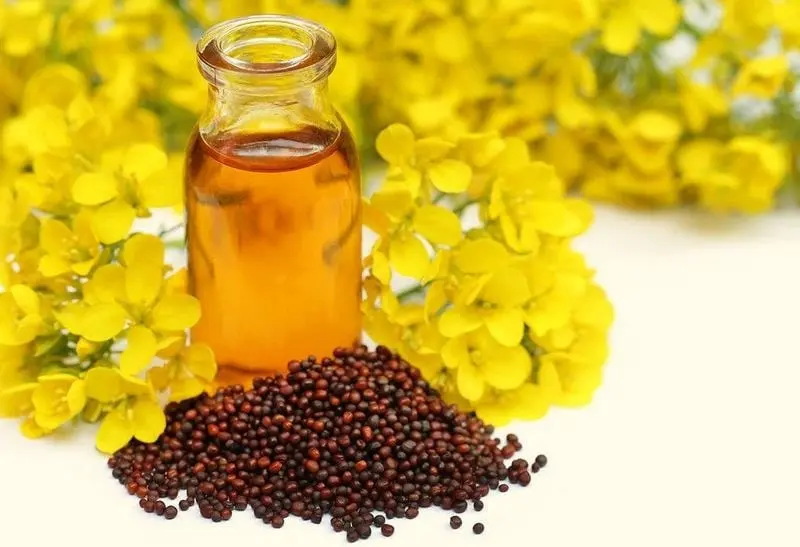
- Improving the functioning of the stomach and intestines.
- Normalization of the work of the heart.
- Destruction of parasites in the liver and dental bacteria;
- Strengthening the immune system.
- Improving vision.
- Clearing the respiratory tract for colds.
- Stimulates blood circulation during massage.
- Regeneration and restoration of damaged skin.
- Strengthens hair and improves skin condition.
The harm of mustard oil
Mustard oil can harm people who have an acidic stomach, an irregular heart rhythm, colitis and pancreatitis.
Like any other product, mustard oil must be consumed in moderation, otherwise it can harm even a perfectly healthy person.
How to choose and store mustard oil?
When choosing mustard oil, it is very important to pay attention to the label and the information it contains, as well as the type of bottle contents. Quality oil should be:
- First spin.
- With sediment.
- Unspoiled (shelf life no more than 12 months).
You can store mustard oil after you open the bottle only in the refrigerator by tightening the cap tightly.
Cooking applications
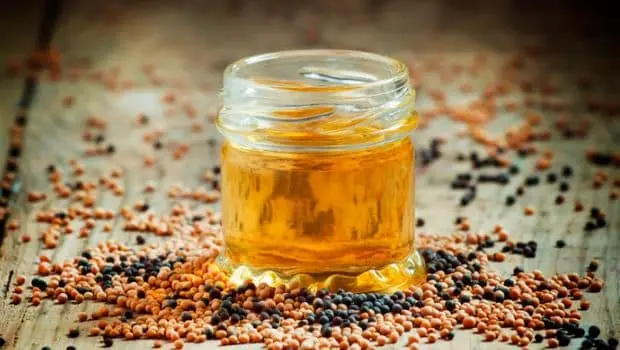
Mustard oil is used in cooking as an alternative to sunflower oil. Most often it is used to prepare various dishes:
- Fry and stew on it.
- Used in salads as a dressing.
- Used as an additive in pickles and preserves.
- Add to baked goods.
Mustard oil is widely used in cooking around the world, but you should not abuse it, the daily rate of such oil for a person is 1-1.5 tablespoons.
The use of mustard oil in cosmetology and dermatology
Improving the function of the epithelium of the mucous membranes and skin, possessing bactericidal, antifungal, antiviral and wound healing properties, mustard oil is in folk medicine an effective remedy for the treatment of skin diseases such as seborrhea, acne (acne), atopic dermatitis, allergic and pustular skin lesions, lichen, herpes, psoriasis, eczema, mycoses.
Due to the high content of phytosterols, beneficially affecting the hormonal background, “vitamins of youth” E and A, polyunsaturated fatty acids, bactericidal substances (chlorophyll, phytoncides), which activates the cutaneous blood circulation, glycoside synegrin, mustard oil has also been successfully used in cosmetology for many years. as a face and body skin care product.
When applied, mustard oil is quickly and deeply absorbed into the skin, contributing to active nourishment, softening, cleansing and moisturizing the skin, and also perfectly protects the skin from the appearance of wrinkles and premature aging associated with a deficiency of female sex hormones or with excessive exposure to ultraviolet rays.
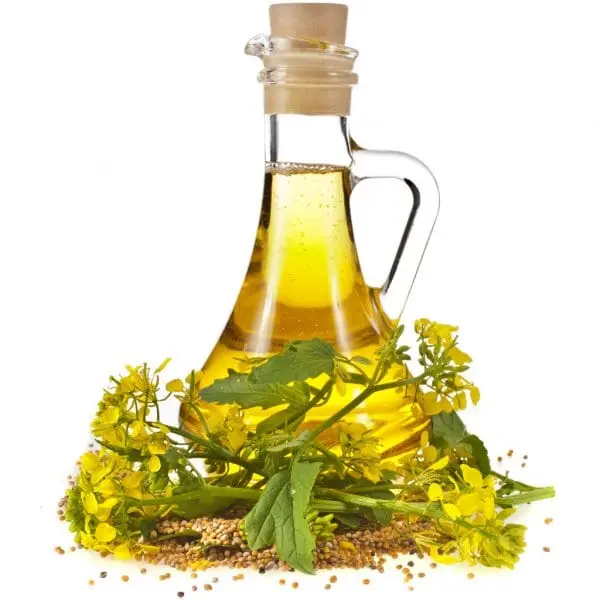
Mustard oil is well known in home cosmetology as a strengthening and revitalizing agent for hair (regular topical application of mustard oil by rubbing it into the scalp and applying it to the hair helps prevent hair loss and premature graying). And due to its “warming”, local irritating property, mustard oil is often used in a variety of massage oils.
In the section “Cosmetic recipes based on mustard oil” you can find out about various options for using mustard oil in home cosmetology.
Application methods
For the treatment and prevention of most diseases listed in the section “The use of mustard oil in the prevention and treatment of various diseases”, it is recommended to use mustard oil internally – 1 teaspoon 3 times a day.
The sections of our website “Healing recipes based on mustard oil” and “Cosmetic recipes based on mustard oil” will tell you about the various ways of external application of mustard oil in home cosmetology and folk medicine.
You can find out about the features and benefits of the culinary use of mustard oil in the section “The use of mustard oil in cooking”.











Asante kwa maelekezo mazuri kuhusiana na haya mafuta
Mimi nina jambo moja ninahitaji hayo mafuta lakini sijui namn ya kuyapata naomb msaada tafadhali
မုန်ညင်းဆီကိုလိမ်းရင်လိင်တံကြီထွားပါလား